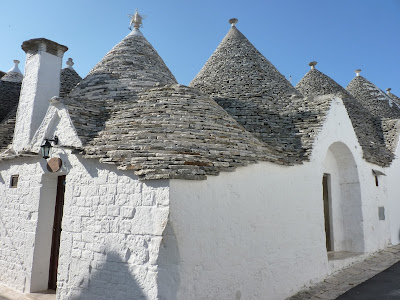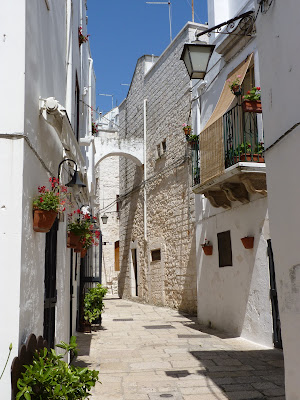 |
| Trani's pretty port |
We descended deeper into the heel of Italy's boot, stopping first in the port town of Trani. The city prospered in medieval times as a religious and maritime center, reaching its apex in the 11th to 13th centuries. Many great families from the major Italian maritime republics (such as Venice, Amalfi and Pisa) established themselves in Trani, and the presence of consuls from Trani in places as far away as England and Holland is evidence of the city's wealth and power. By the 12th century, Trani had one of the largest Jewish communities in southern Italy, although persecution ensued in later years. We walked around the picturesque port, took refuge from the heat in the shade of the cathedral, and ate another superb seafood meal. We spoke with the restaurant owner about the differences between the cuisine in the north and the south and it was pretty clear where her preferences lay - in describing the food of the north she used phrases like "pesante" (heavy), "troppo di burro" (too much butter), and "non come sano" (not as healthy). I'd hate to know what she thinks of American cuisine!
 |
| Trani's Cathedral |
The next stop, Alberobello, may have been the highlight of our Puglian adventure. The town is glaringly white and is famous for its "trulli." A "trullo" (the singular of "trulli") is a traditional whitewashed stone hut with a conical roof, whose style of construction is said to be unique to this area of Italy. In fact, it's not
that unique, as the trulli in Alberobello immediately called to mind the conical mud-brick structures we saw in January 2011 in
Harran in southeastern Turkey. In any case, the town is ridiculously adorable and I took a ridiculous number of pictures. Unlike the other places we visited in Puglia, there were a fair number of tourists about, and we met people from France, Japan, the United Kingdom and the Bronx.
 |
| Church in Alberobello |
 |
| The white towns of Puglia |
The area around Alberobello is littered with pretty whitewashed medieval towns, which have cool names like Locorotondo, Martina Franca, Cisternino, and Ostuni. We looked hard for a place name that ended in a consonant, but we didn't find one. The towns run together somewhat in my mind - they're all white, they're all beautiful, and they all have narrow little alleyways where you can get joyfully lost for an entire afternoon.
One memorable point during our travels in the white towns of Puglia was the dinner we had in Locorotondo. There was no menu and instead they just brought out plates of food - absolutely delicious plates of food - until we said "basta cosi." It was reminiscent of our first meal in Puglia in San Severo (which is described in our previous
post). There was one particularly memorable and unusual dish of orecchiette with whole black chickpeas. I haven't found that dish since, but somehow, somewhere, I will eat it again.



 |
| Ostuni skyline (photo taken from the internet) |
 |
| Lecce - "The Florence of the South" |
Our time in Puglia was coming to a close and we had to be in Rome in two days to meet my brother's family from New York City. The prudent plan of action would have been to start heading north towards the capital. Another, more foolhardy option would have us go deeper into southern Puglia, to almost the tip of the heel of the boot, to the city of Lecce, before pulling an abrupt u-turn with seven hours to go to reach Rome. Can you guess which course of action we chose? Well, Lecce was worth it. It's been called "the Florence of the South" due to the wealth of monumental Baroque buildings, although not all are in agreement about whether they like it or not. The 18th-century traveler Thomas Ashe declared it was "the most beautiful city in Italy," but the less-impressed Marchese Grimaldi said that the façade of Lecce's famous Santa Croce Basilica made him think a lunatic was having a nightmare. Either way, there's no doubt that the level of architectural ornamentation is - in Jeremy's words - "way over the top." Apparently, the stone used for construction was quite malleable, but durable at the same time, making it perfect for elaborate sculpting.
 |
| Santa Croce in Lecce - the most beautiful city in Italy, or the nightmare of a lunatic? |
After finishing our tour in Lecce in the hottest part of the afternoon, we got back into the rental car, turned the air conditioner to its highest setting, and started heading back towards the north to see how much ground we could cover by sundown...
 |
| More photos of Trani |
 |
| We ate a fantastic seafood lunch here |
 |
| The big ship on the wall gives you an idea of what kind of food they serve |
 |
| More photos of Alberobello |
 |
| "Ready to wear fashion" |
 |
| Wedding at the church |
 |
| Church in Alberobello under a full moon |
 |
| More photos from the white towns of Puglia that end in a vowel |
 |
| Unfortunately, only a few small wedding gifts can fit in the car |
 |
| More photos from Lecce |













































































No comments:
Post a Comment